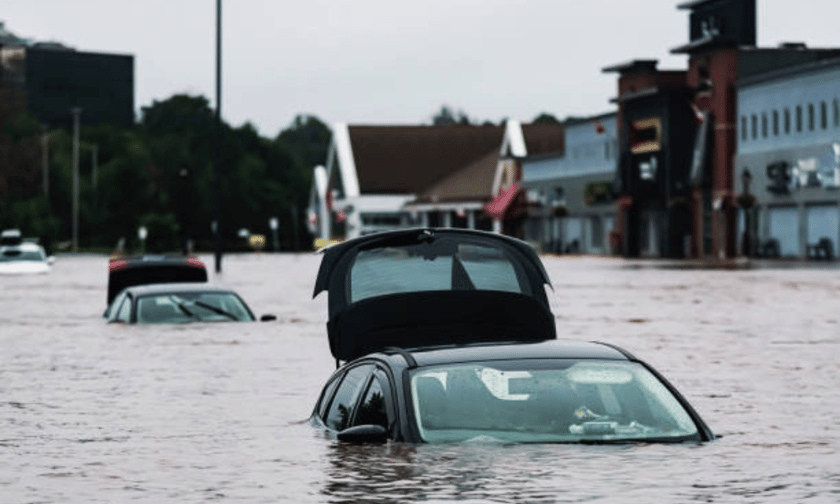

The extreme losses being experienced by the insurance industry have some industry stakeholders considering the unthinkable: will the industry collapse? Regulators and insurance leaders in Australia were asked this question at a government inquiry’s public hearing.
The inquiry is looking at insurance unaffordability and unavailability due to climate-driven disasters, like the 2022 floods that cost the industry AU$6.3 billion – a country record.
While its hearings were underway, in the United States, Florida was hit by the first of back-to-back hurricanes. Estimates suggest the total insurance cost of hurricanes Helene and Milton could be a jaw dropping US$55 billion.
In late September, heavy rainfall in Nepal caused floods and landslides. The United Nations reported that more than 200 people died and 4,500 were rescued. The capital city, Kathmandu was inundated. Insurance losses, however, were relatively low.
Meanwhile, Canada has experienced its most destructive summer in history with CA$7 billion in losses from floods and wildfires. The UK, particularly Wales, is currently experiencing flooding. Rainfall was unusually high in September and 2023 was that country’s wettest year ever.
In this context, questioning the insurance industry’s survival doesn’t seem far-fetched.
The chair of the inquiry, Australian Greens Senator Mehreen Faruqi, prefaced the question by stating that climate disasters are getting more intense and frequent.
She said to Christopher Wallace, CEO of the Australian Reinsurance Pool Corporation (ARPC), if this collapse happens, would state backed insurers and reinsurers, like the ARPC, be the only ones left?
Wallace said that his conversations with government and the insurance sector inform him that there is “enormous momentum” around “shared thinking on how to reduce disaster risk in the community.”
“The long term solution is to reduce the risk, not just to address the insurance premium,” said Wallace.
The Actuaries Institute’s CEO, Elayne Grace, was the next industry stakeholder to face questions.
“Is there a risk that the insurance industry could actually collapse if the climate crisis continues, especially without a dramatic reduction in emissions?” asked the chair.
“The insurance industry provides one-year policies,” said Grace. “In that sense, they are just being exposed, they can always walk away from the market.”
However, the CEO was concerned that this means it will fall on governments to deal with climate-driven disasters. Like Wallace, she said it was important for the government, insurers and the community to work together to reduce risk.
“What is the most dire scenario facing the insurance industry if emissions don’t come down and if governments don’t intervene?” asked Faruqi, this time to Kylie Macfarlane, chief operating officer of the Insurance Council of Australia (ICA).
“I’d say first that the insurance industry is very competitive and sustainable at this point in time,” said Macfarlane. “It is there to create a safety net for Australians to cope with the day-to-day calamities that happen.”
However, she said the insurance industry has paid out over AU$20 billion in extreme weather claims since Australia’s Black Summer bushfires of 2019-20.
Faruqi asked her question again.
“Is the very survival of the insurance industry under serious threat as well, given our greenhouse gas emissions strategy, unless things change?” she said.
This time Jonathan Barratt, CEO of the insurtech, CelsiusPro Australia, was answering. He said “indemnity style” insurance is facing issues.
“I think the parametric solutions should be encouraged because they offer an alternative risk transfer method,” said Barratt.
He said more reinsurers and insurers are getting involved in parametrics.
“Would you agree that there is a real risk that the insurance industry itself goes down?” asked Faruqi once more, this time to academics from Melbourne’s Monash University.
“I think that there’s obviously a lot of pressure on the system, on private insurers,” said Dr Antonia Settle. “As to whether they go down or not, whether insurers collapse, I think there’s probably a bit more nuance going on there.”
Settle lectures on households and financial risks.
“I think the issue is more about their market shrinking and them relying ever more on state subsidies,” she said.
As well as considering the prospect of total industry collapse, the hearing also looked at the implications of what many see as the current situation of partial collapse.
California has seen insurers exit the home insurance market completely because of fire risks. Australia has similar coverage challenges for flood, fire and cyclone risks in a growing number of locations where insurance is unavailable or unaffordable.
Tyrone Shandiman, chair or the Australian Consumers Insurance Lobby (ACIL) and managing director or an insurance brokerage, said the “the market is failing” and called for more government intervention.
He was asked by Labor Party Senator Tony Sheldon – the inquiry’s deputy chair – to highlight why he sees the insurance sector as failing?
“I spoke to a pensioner up in Townsville who had to sell her unit because she was being charged $16,000, or 40%, of her pension for insurance,” said Shandiman. “How is that not market failure?”
He said ACIL has data that shows some consumers are paying up to 20 times as much for insurance as others. Many people in high risk areas, said Shandiman, are now choosing not to take out insurance against these perils and then need government help.
Karl Mallon said this growing problem is probably creating “climate ghettos” in the developed world.
Mallon is Sydney-based CEO of The Climate Risk Group.
“In the most extreme situations, we’ll need to see property buybacks, which means properties need to be taken off market,” he said. “They’re not safe and they’re not financially viable, and property rights need to be withdrawn and reallocated to safer places.”
He referred to New Zealand where property buybacks have been adopted after some serious flood events.
Do you think the insurance industry is going to collapse? Please tell us your thoughts below.
